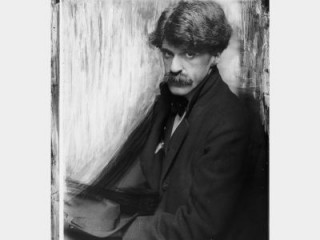
Alfred Stieglitz biography
Date of birth : 1864-01-01
Date of death : 1946-07-13
Birthplace : Hoboken, New Jersey
Nationality : American
Category : Famous Figures
Last modified : 2010-11-22
Credited as : Photographer, art gallery diretor and editor,
Alfred Stieglitz, American photographer, editor, and art gallery director, was a leader in the battle to win recognition for photography as an art.
Alfred Stieglitz was born in Hoboken, N.J., on Jan. 1, 1864. In 1871 the family moved to New York City, where Stieglitz attended elementary schools and the College of the City of New York until 1881. He then studied at the Realgymnasium in Karlsruhe, Germany, and the Berlin Polytechnic Institute. He enrolled in the photographic courses of Hermann Wilhelm Vogel, an outstanding photographic scientist. As a student, he traveled extensively throughout Europe and, beginning in 1886, sent photographs to competitions. By 1890, when he returned to America, he was already famous.
In the United States, Stieglitz continued to photograph, using the newly invented hand camera and surprising his contemporaries with such a technical tour de force as "Winter on Fifth Avenue," taken in 1893 during a blizzard. He organized competitions and exhibitions in camera clubs and from 1890 to 1895 was in the photoengraving business. He was editor of the American Amateur Photographer (1893-1896), Camera Notes (1897-1902), which was the official organ of the Camera Club of New York, and Camera Works (1902-1917).
When the National Arts Club of New York invited Stieglitz to hold an exhibition in 1902, he showed the work of those American photographers in whom he believed. He described the exhibition as the work of the Photo-Secession. Thus an informal society was formed that dominated art photography in America for 15 years. His chief colleague was a young photographer and painter, Edward Steichen, who assisted him in the society's Little Galleries, which came to be known as "291" from the Fifth Avenue address.
In 1907 Stieglitz began to show works of art other than photography at "291." In 1908 he exhibited drawings by the sculptor Auguste Rodin and drawings, lithographs, etchings, and watercolors by Henri Matisse—the first American exhibition of this modern artist. "291" became the most progressive art gallery in the country, showing the work of Pablo Picasso, Constantin Brancusi, Henri de Toulouse-Lautrec, and young Americans such as John Marin.
In 1910 Stieglitz organized a vast exhibition of pictorial photography in Buffalo, N.Y. He helped the Association of American Painters and Sculptors to organize the "International Exhibition of Modern Art" in 1913. During the exhibition he showed his own photographs at "291" as a demonstration of the esthetic differences between photography and other visual media.
The "Photo Secession" disbanded in 1917, "291" closed, and Camera Workceased publication, but Stieglitz continued to photograph and exhibit. He made penetrating portraits of his friends and associates. In answer to a challenge that his photographs' power was due to his hypnotic influence over his sitters, Stieglitz began to photograph clouds, to show, as he wrote in 1923, "that my photographs were not due to subject matter." He called these photographs "Equivalents," and they almost rivaled abstract art in their beauty of form and chiaroscuro.
In 1929 Stieglitz opened An American Place, a gallery where he showed paintings by contemporary Americans and, later, photographs. From the windows of this 17th-floor gallery and from his apartment he photographed New York City. He died on July 13, 1946.
Dorothy Norman, Alfred Stieglitz: Introduction to an American Seer (1960), whose text consists mainly of Stieglitz's recollections as told to the author, is handsomely illustrated; the detailed chronology is invaluable. Doris Bry, Alfred Stieglitz, Photographer (1965), reproduces, in original size, 62 photographs in the collection of the Museum of Fine Arts, Boston; the text is concerned with Stieglitz's photographic activity. America and Alfred Stieglitz: A Collective Portrait, edited by Waldo Frank and others (1934), contains many brilliant essays which illuminate Stieglitz's philosophy and the breadth of his concern for the arts in America. Herbert J. Seligmann, Alfred Stieglitz Talking (1966), is a vivid journal of the author's visits with Stieglitz from 1925 to 1931.
Eisler, Benita, O'Keeffe and Stieglitz: an American romance, New York: Doubleday, 1991.
Kim, Yong-gwon, Alfred Stieglitz and his time: an intellectual portrait, Seoul, Korea: American Studies Institute, Seoul National University, 1978.
Lowe, Sue Davidson, Stieglitz: a memoir/biography, New York:Farrar Straus Giroux, 1983.
Norman, Dorothy, Alfred Stieglitz: an American seer, New York:Aperture, 1990.
















